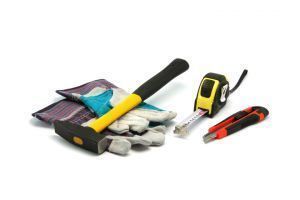The Basic Homeowner Toolbox
Updated: 2022-01-12
By: Paul Bianchina
Home improvements of any size, shape or complexity all have one thing in common: they need tools. If all you have in your home is a broken screwdriver, a hammer without a handle, and one wrench you hope will happen to fit whatever bolt you encounter, you need some help.
The following is a basic set of tools that no homeowner should be without. When outfitting your toolbox, buy only quality tools, even if you have to collect them a few at a time. Low end tools are inaccurate, frustrating to use, and often unsafe, while good tools are a joy to use and an investment that will last you a lifetime.
Home improvements of any size, shape or complexity all have one thing in common: they need tools. If all you have in your home is a broken screwdriver, a hammer without a handle, and one wrench you hope will happen to fit whatever bolt you encounter, you need some help.
The following is a basic set of tools that no homeowner should be without. When outfitting your toolbox, buy only quality tools, even if you have to collect them a few at a time. Low end tools are inaccurate, frustrating to use, and often unsafe, while good tools are a joy to use and an investment that will last you a lifetime.

- Hammer: A 16 ounce hammer with a curved claw and a smooth, slightly crowned (convex) face will work for most of your repairs. Wood, metal or fiberglass handles are all fine - just look for one that feels comfortable in your hand and has a solid point of attachment between the head and the handle.
- Screwdrivers: Purchase a full set of screwdrivers with hardened tips, including standard and Phillips heads in three sizes of each. Again, look for a nonslip grip that is comfortable in your hand. A handy and less expensive alternative is the 4 in 1, which has the two most commonly uses sizes of both standard and Phillips screwdrivers, all of which interchange in one common handle.
- Tape measure: A 16 foot or 25 foot retractable steel tape measure with a locking mechanism will work for just about every measuring task you're likely to encounter. For use in the shop or garage, a 10 foot tape is a little less bulky.
- Adjustable wrenches: A set of three good quality adjustable wrenches - small, medium and large - will fit a very wide range of nuts and bolts and should be all you'll ever need. Check for a comfortable handle and smooth operation of the adjustment knob.
- Flashlight: Flashlights are indispensable. To ensure that it's operational when you need it, look for one with a heavy-duty metal case that is powered by three or four D cell batteries.
- Utility knife: Get a metal utility knife with retractable, replaceable blades, along with a pack of heavy-duty blades.
- Putty knives: The well equipped toolbox will have three putty knives: one with a stiff 1½ or 2 inch wide blade for scraping, one of the same width but with a flexible blade for puttying and patching, and a 6 inch wide drywall taping knife, which can be used for larger patching, light scraping and as a painting guide.
- Paint brushes: Acquire a set of two or three good quality paint brushes that are rated for use with all paints. For most people, the most commonly used sizes are 1½ inch, 2½ inch, and 3 inch.
- Pry bar: You'll need a medium length pry bar that is flat on one end and curved at a 90 degree angle at the other. You should also consider adding a smaller version, which is perfect for small moldings, and a large, heavy-duty version for those big tear out chores.
- Pliers: Get a pair of standard 7 inch or 8 inch slip joint pliers, and a pair of diagonal cutting pliers. Look for a comfortable grip, easy operation of the handles and a slip mechanism that stays in place after it's moved.
- A saw: You will need something to cut wood, and what you get is usually more a matter of budget. At the very least, invest in a good quality crosscut handsaw with a wooden handle (plastic handles are uncomfortable and break too easily). A more versatile choice is a medium or heavy-duty 7¼ inch electric circular saw.
- Level: A two foot long wood or aluminum level (not plastic) is the minimum necessary for most homeowner projects. You can add a four foot one when money permits.
- Caulking gun: You should have a caulking gun that fits standard caulking tubes.
- Extension cord: At a minimum, you should have a 25 foot grounded extension cord with 14 gauge wires. Larger tools may require heavier cords, so be sure to check the tool manufacturer's recommendations for specifics.
- Cordless drill/driver: Once a luxury item, increases in battery power and decreases in cost have made this one of the most useful tools in your arsenal. Look for a complete kit that includes the drill, an extra battery, a battery charger and a case. The drill's power is dictated by the voltage of the battery, which ranges from around 7 volts to a hefty 24 volts. A 9.6 volt unit is the minimum size that's worth considering. Lack of power on the smaller models is simply too frustrating to work with. The 14.4 or even the 18 volt models are a worthwhile step up.
Comments (0)
